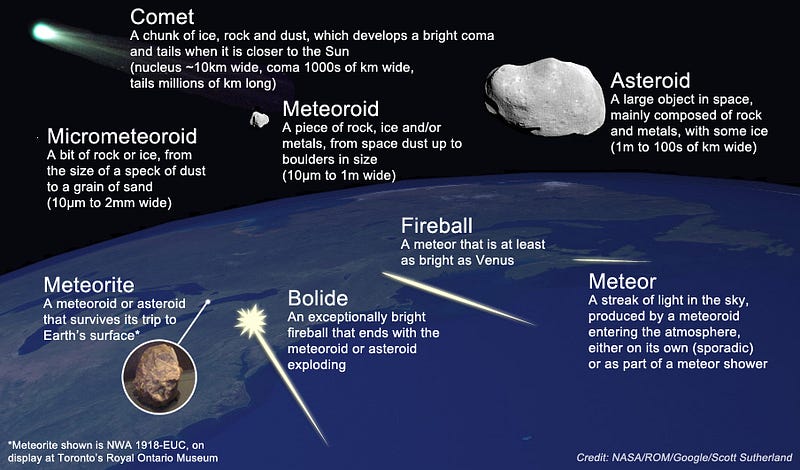Exploring the Wonders of Our Second Interstellar Visitor
Written on
Chapter 1: Understanding Interstellar Objects
In late 2017, the solar system welcomed its first interstellar visitor, known as ‘Oumuamua (officially designated 1I/2017 U1). Now, another interstellar object has been identified: the comet named “2I/Borisov.” This fascinating comet is set to traverse our Solar System, offering a unique opportunity to study its characteristics.
Every day, Earth is bombarded by numerous asteroids, meteoroids, and comets, most of which are native to our solar system and display subtle variations. Let’s briefly review these celestial bodies before diving deeper into today’s topic.
Asteroids are rocky formations that orbit the Sun, falling between the sizes of planets and small pebbles. The asteroid belt, located between Mars and Jupiter, is home to the largest collection of these objects in our Solar System.
Occasionally, asteroids collide, resulting in smaller fragments known as meteoroids. When these meteoroids enter the Earth’s atmosphere, they produce visible streaks of light called meteors, often referred to as “shooting stars.” Some meteors manage to survive the descent and land on Earth, where they are classified as meteorites.
Comets, on the other hand, are icy bodies that also orbit the Sun. As they approach the Sun, the heat causes their ice to vaporize, creating a long, glowing tail. Unlike meteors that are only seen during atmospheric entry, comets can be observed from great distances. One of the most famous comets, Halley’s Comet, was discovered by the English astronomer Edmond Halley and returns roughly every 75 to 76 years.

Chapter 2: The Discovery of 2I/Borisov
On August 30, 2019, Gennady Borisov, an amateur astronomer from Ukraine, observed a fast-moving comet through his telescope. Subsequent observations from the Gemini Observatory in Hawaii and the William Herschel Telescope in Spain confirmed that it is indeed a comet of interstellar origin, characterized by its hyperbolic trajectory.
Tracking the trajectory of such celestial bodies helps determine their origins. If an object follows an elliptical orbit, it is likely part of the solar system. Conversely, a hyperbolic path indicates an interstellar origin. Recent observations have revealed that this comet possesses a tail stretching approximately 6.2 miles (10 kilometers) and is traveling too rapidly to be captured by the Sun’s gravity.
The Minor Planet Center at Harvard & Smithsonian Center for Astrophysics has designated this comet C/2019 Q4 (Borisov) in honor of its discoverer. Additionally, astronomers have released a vibrant image of the comet.

Chapter 3: Comparing Interstellar Visitors
Initially named gb00234, C/2019 Q4 (Borisov) is now recognized as the second interstellar visitor to our solar system. The first was the renowned ‘Oumuamua, a cigar-shaped object that sparked speculation of being an alien spacecraft due to its unusual form. Discovered in late 2017, ‘Oumuamua was already on its way out of the solar system, limiting the time researchers had to study it.
Fortunately, C/2019 Q4 (Borisov) will remain visible for several months, providing ample opportunities for observation. This comet is notably six times brighter than ‘Oumuamua. It will make its closest approach to Earth at approximately 1.8 AU on December 10th, with one astronomical unit (AU) representing the average distance between the Earth and the Sun. When discovered, the comet was about 3 AU away.
The future looks promising as powerful observatories, such as the James Webb Telescope, are set to become operational by the mid-2020s, potentially uncovering even more interstellar objects in our vicinity. In the meantime, astronomers are dedicating their resources to study this remarkable celestial visitor.
The first video titled "New Interstellar Object from Cassiopeia Found - Another 'Oumuamua?" delves into the details surrounding this exciting discovery and its implications for our understanding of space.
The second video, "New Discoveries from Our Second Interstellar Visitor | SciShow News," explores the findings related to 2I/Borisov and what they mean for future astronomical research.
Stay connected to the latest updates on celestial phenomena — subscribe to my mailing list for insights that matter!